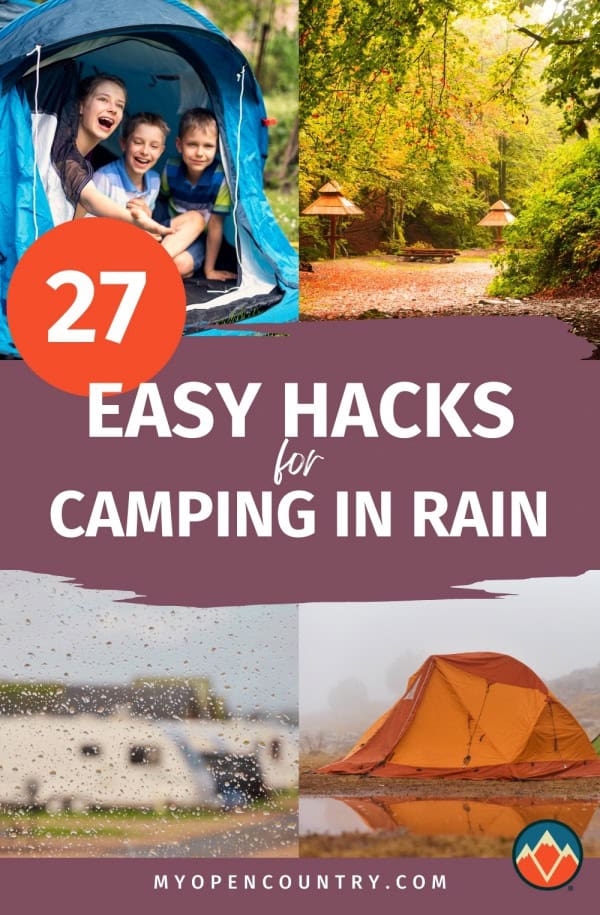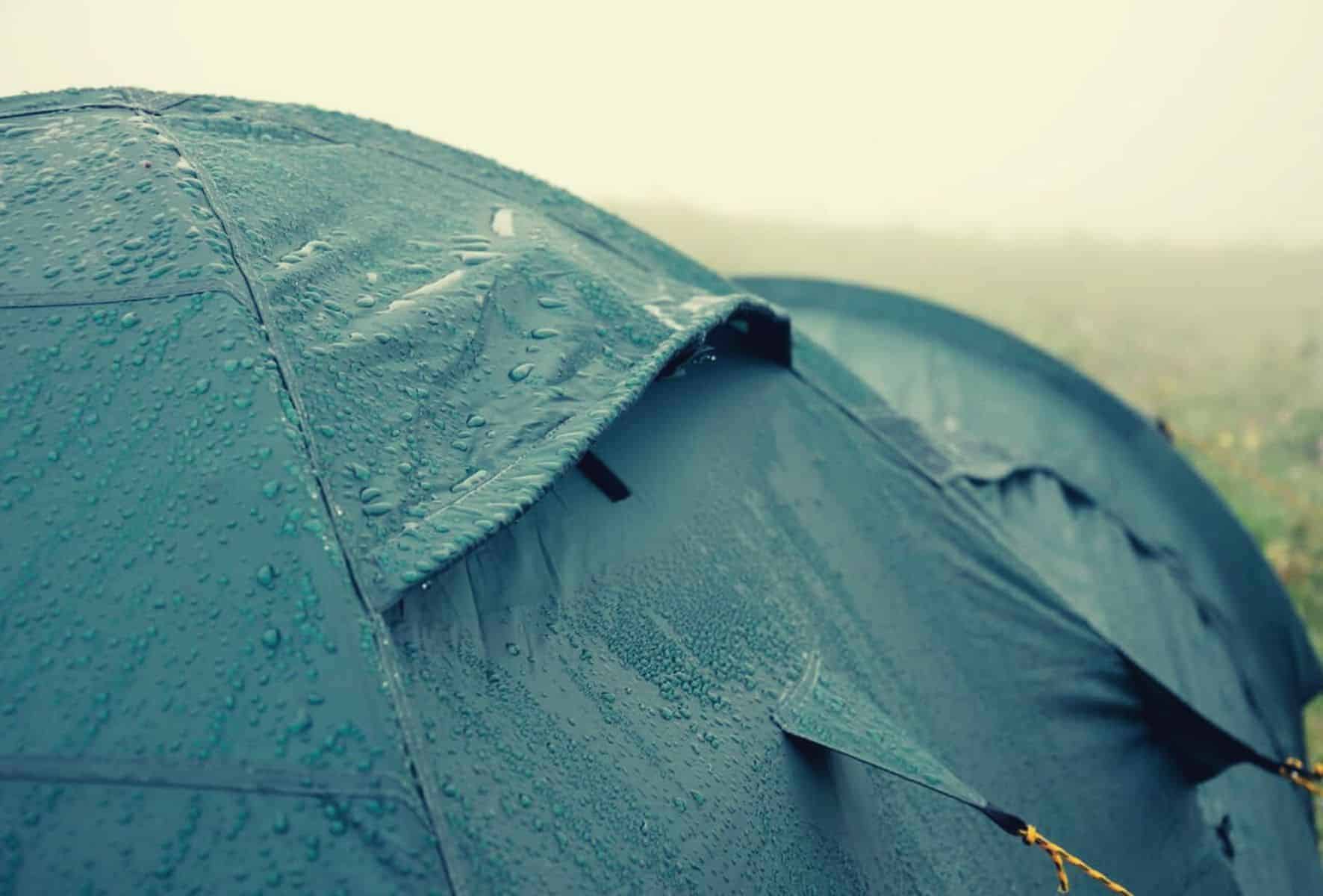Camping in rainy conditions adds complexity to any camping trip. How do you stay dry while performing essential tasks? How can you protect your gear from getting wet? What additional equipment should you bring?
This guide outlines our top 27 tips and hacks for rainy camping adventures. We cover what to pack, how to prepare, pitching your tent in the rain, how to enhance camp comfort, and the all-important post-trip gear maintenance.
Do
Don’t
Save for later!!! ⤵️
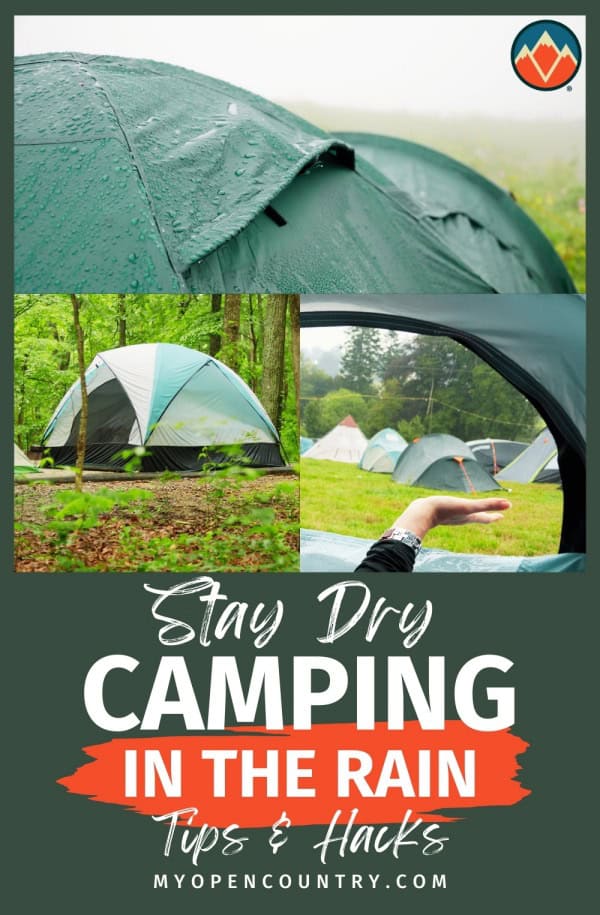
Starting with prepping and ending with post-trip maintenance here are our top tips for wet-weather camping.
- Waterproof Camping Gear
- Know Before You Go
- Manage Expectations
- Bring A Good Book
- Go Synthetic
- Pack A Few Garbage Bags
- Pack No-Cook Grub
- Keep Gear Dry With Drybags
- Prep For Pyrotechnics
- Bring A Microfiber Towel
- Make Mini-Maps
- Bring the Right Gear
- Prioritize Pitching
- Protect Tent Floor With Tarp
- Substitute Stakes For “Deadmen”
- Avoid Flood Areas
- Avoid “Widowmakers”
- Dig A “Moat” Around Your Tent
- Create A Dry Zone With A Tarp
- Rig A Drying Line Under Your Tarp
- Bag Up Your Damp Clothes
- Use Your Bivvy Bag To Create A Vestibule
- Stash Dry Wood Under Your Car
- Change Clothes Before Bed
- Slow-Dry Gear In Your Sleeping Bag
- Know When Enough Is Enough
- Clean And Air Out Your Gear
Table of Contents
- How To Camp In The Rain? Key Takeaways
- 1. Waterproof Camping Gear
- 2. Know Before You Go
- 3. Manage Expectations
- 4. Bring A Good Book
- 5. Go Synthetic
- 6. Pack A Few Garbage Bags
- 7. Pack No-Cook Grub
- 8. Keep Your Gear Dry With Drybags
- 9. Prep For Pyrotechnics
- 10. Bring A Microfiber Towel
- 11. Make Mini-Maps
- 12. Bring the Right Gear
- 13. Prioritize Pitching
- 14. Protect Tent Floor With Tarp
- 15. Substitute Stakes For “Deadmen”
- 16. Avoid Flood Areas
- 17. Avoid “Widowmakers”
- 18. Dig A “Moat” Around Your Tent
- 19. Create A Dry Zone With A Tarp
- 20. Rig A Drying Line Under Your Tarp
- 21. Bag Up Your Damp Clothes
- 22. Use Your Bivvy Bag To Create A Vestibule
- 23. Stash Dry Wood Under Your Car
- 24. Change Clothes Before Bed
- 25. Slow-Dry Gear In Your Sleeping Bag
- 26. Know When Enough Is Enough
- 27. Clean And Air Out Your Gear
1. Waterproof Camping Gear
Before embarking on wet-weather camping trips invest in your future self’s safety, sanity, and general well-being by waterproofing your gear. This involves reproofing your tent, specifically by reapplying the DWR coating to your inner tent, sealing the seams, and checking for and repairing any tears or punctures. Additionally, reproof rain pants, jackets, and your backpack.
Gear that isn’t up to the task is probably the most common cause of any camper’s misery. While in fair weather the consequences of kit cock-ups can be bad enough, in wet conditions they can lead to an almost endless array of calamities and discomforts.

2. Know Before You Go
Knowing how to pitch your tent in advance will save you a lot of pain later. Ideally, practice pitching your tent at least four or five times in your garden or local park before venturing out on your first wet-weather camping trip. If you haven’t camped in a while you may also want to refresh your memory. While it may seem like a chore, it’s better than dealing with these challenges for the first time in a downpour.
Many beginner campers underestimate just how tricky it can be to pitch a tent properly, even more so how much the process can be complicated and slowed down by a little bit of airborne H20.
3. Manage Expectations
If the forecast predicts rain, it’s crucial to manage your expectations to avoid disappointment. Envision how things will unfold and recognize that this trip will have limitations compared to trips you take in fair conditions. Chances are you’ll spend a lot of time in your tent or under a tarp, hiking in low visibility, squelching through mud in a full waterproof arsenal, and trying to minimize how soaked you and your gear become.
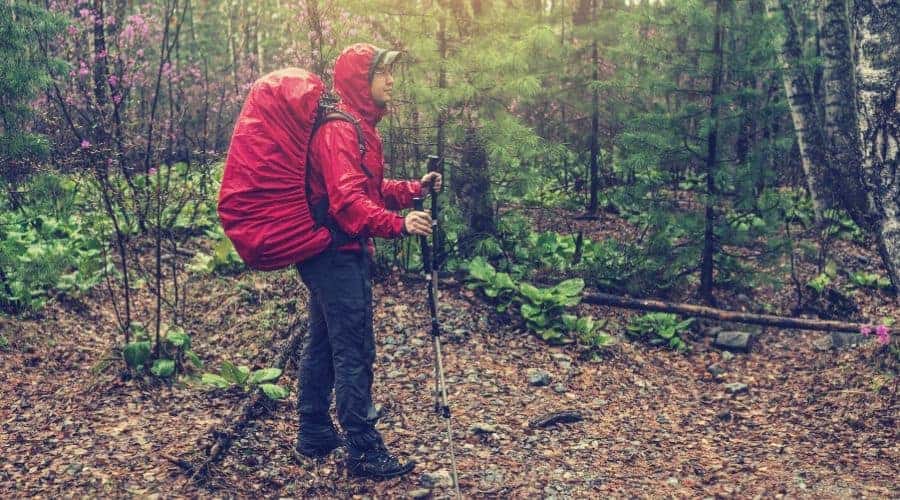
4. Bring A Good Book
A great way to pass the time when rain showers are a touch too biblical to even consider stretching your legs is by diving into a good book. Some top outdoor-themed recommendations include “Wild” by Jay Griffiths, “Walden” by Henry David Thoreau, and “Nature Cure” by Richard Mabey, all excellent starting points.
5. Go Synthetic
In wet conditions, synthetic sleeping bags outperform those made from down. While down sleeping bags are often considered the best due to their excellent warmth-to-weight ratio and plush feel, they have significant drawbacks: they don’t insulate well when wet and take an age to dry.
6. Pack A Few Garbage Bags
While not the most high-tech accessory, a garbage bag has numerous potential uses when camping in wet conditions. They can moonlight as inexpensive dry bags, doormats, ground cloths, temporary repair patches for torn tents or clothing, mini-tarps for stashing shoes and gear under, food bags, rain covers for backpacks, and laundry bags to keep wet and dry clothes separate.
They’re also pretty handy for throwing your trash in, too…
7. Pack No-Cook Grub
While we provide a helpful hack below for starting a campfire in the rain, when conditions are excessively wet it’s wise to pack a few no-cook meals to save yourself the trouble. Our cold-menu food suggestions, while not gourmet, include tuna pre-mixed in a Ziploc bag with salad, hearty sandwiches, couscous, cold pizza, beef jerky with guacamole, hot dogs with mustard, and various salad options.
As an added bonus, pre-preparing cold meals also means cutting down on mess (and, ergo, cleaning) and pack weight (cooked items usually weigh less than uncooked and you can also leave the cooking utensils at home).
8. Keep Your Gear Dry With Drybags
To help keep things clean and tidy, both in your backpack and within your tent, it’s worthwhile to pack your gear into several dry bags and Ziploc bags. This will protect clean and dry items from becoming muddy and wet, and allow you to store smelly, soaked, and dirty gear with the assurance that it won’t affect the other contents of your pack.
9. Prep For Pyrotechnics
Prepping for pyrotechnics means you can ignite a decent blaze in nearly any weather. First, douse a few cotton balls in petroleum jelly to use as firelighters and stash them in a Ziplock bag. Second, take an empty egg box, stuff a lump of charcoal in each compartment, wrap it in a sheet of newspaper, and add it to your backpack. When you arrive at camp, find a dryish spot, stuff the cotton balls and paper under the egg box, and ignite.
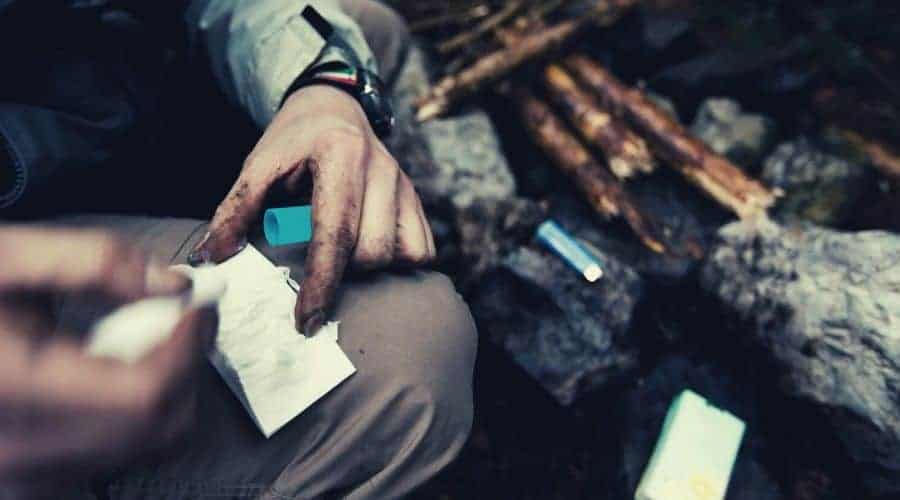
10. Bring A Microfiber Towel
Microfiber towels are invaluable on wet-weather camping trips. One such use is for wiping away condensation inside your tent and drying the rainfly before storage. Afterward, wring out any remaining water from the towel and attach it to the outside of your pack. This saves packing a sodden tent away in your backpack, preventing saturating everything else inside and avoiding adding unnecessary weight to your load.
11. Make Mini-Maps
Anyone who has hiked in the rain will know the frustration of trying to prevent a paper map from turning to slush. You can get around this problem by printing route cards at home and then taking them to a store to have them laminated. Alternatively, invest in a personal laminator to craft your own pocket-sized, completely waterproof, and hassle-free mini-maps.
Using a waterproof map holder, there will inevitably come that point where your trail veers over the page and you are forced to remove the map, adjust it to the right spot, and then squeeze it back in the holder again without getting it wet—a task that would land you a place in the final of America’s Got Talent if you could accomplish it successfully.
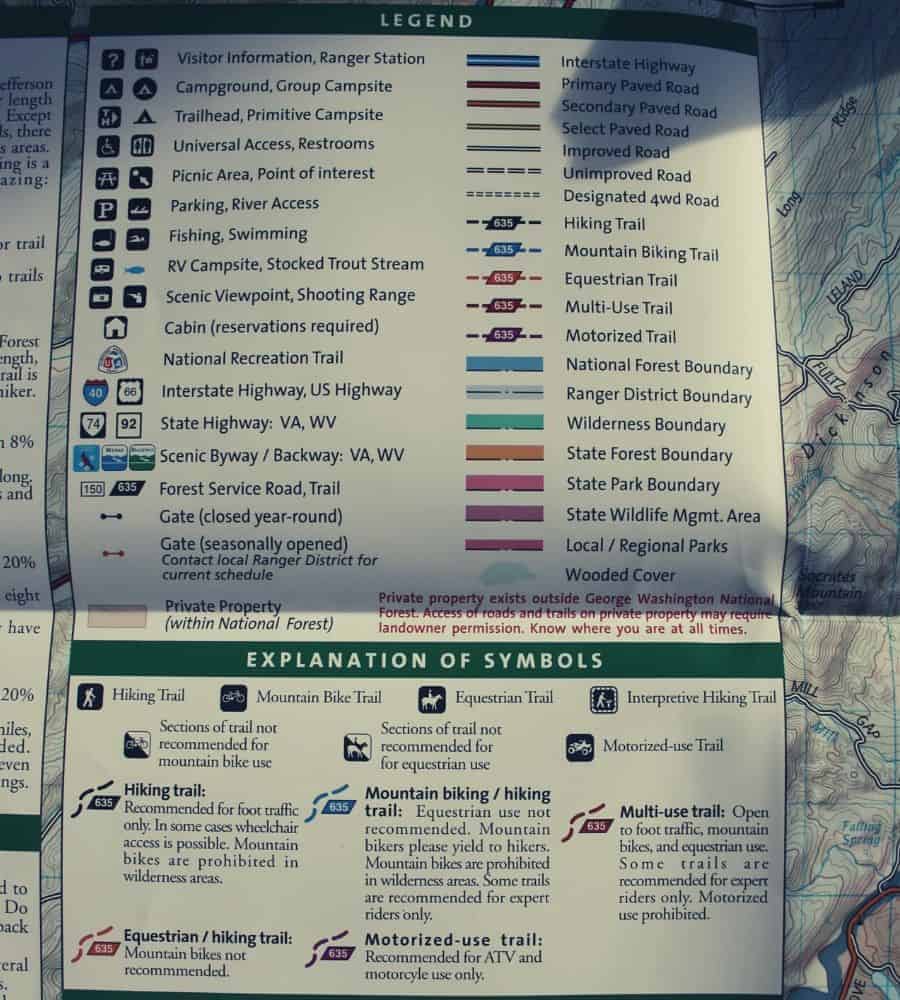
12. Bring the Right Gear
Bringing the right gear may seem obvious, but some people still venture into the wild attire ill-equipped for anything beyond a light drizzle, never mind a deluge. The best place to begin is with the layering system. Start with a moisture-wicking and temperature-regulating base layer, preferably made of merino wool. Add a substantial mid-layer for warmth and lastly, a Gore-Tex (or similar) rain jacket to repel the elements.
Finish off with a pair of waterproof boots and a tent with a rain fly capable of dealing with oodles of airborne H2O and your foul-weather camping trip might just not turn out to be your funeral, too.
13. Prioritize Pitching
Upon reaching your campsite, it’s tempting not to prioritize pitching your tent. Instead, don your shell layer and get it done! First, get the fly up ASAP, get under it, then pitch the inner tent safe in the cozy nook of living space you’ve created with the fly. Third, huddle inside, rejoice, eat some food, and give thanks for stumbling upon this invaluable piece of advice.
Setting up a tent in the rain is no different to setting up in glorious sunshine, just a whole lot less fun. That’s why, when you reach camp, you should get it over with ASAP. If it’s dry upon arrival, Sod’s Law dictates that it won’t be when you finally decide to put up your tent.
14. Protect Tent Floor With Tarp
Placing a tarp, or a heavy duty garbage bag, under your tent not only reduces wear and tear on your tent floor but also offers an additional layer of insulation and increased defense against potential groundwater infiltration. Just be sure to tuck any surplus fabric under the tent body to ensure it doesn’t act as a pooling place for runoff from the tent walls.
15. Substitute Stakes For “Deadmen”
If conditions underfoot are especially wet you might struggle to get standard tent pegs or stakes to hold in the boggy ground, instead, you can use “deadmen” to ensure your tent stays upright and stable. A “deadman” is a mountaineering device used as an anchor for abseiling or rappelling in snow.
The same principle can be applied when pitching your tent in the absence of suitably solid ground—simply tie the ends of a guy line around a rock, tension the cord, and then place the rock in the boggy ground, giving it a stamp to “bury” it if necessary and you’re sure you won’t be damaging any fragile plantlife in doing so.
16. Avoid Flood Areas
To avoid being caught in a flash flood, or simply waking up in a small pond of rainwater, make sure your campsite is situated away from river banks, depressions in the terrain, narrow canyons or gulches, dry washes, or river basins. Also, choose a spot that’s slightly elevated in the terrain as an added precaution.
17. Avoid “Widowmakers”
Camping in rainy weather may tempt you to pitch your tent under trees for protection, however, if one of these trees is a “widowmaker” it could prove to be a deadly decision. Widowmakers are trees that typically have a rotten branch that stormy weather might cause to break off and tumble onto our tent. Alternatively, they may also attract lightning during electrical storms, posing a separate safety risk.
The take-home? Get your glasses on and inspect branches above you thoroughly before parking your tent under them.

18. Dig A “Moat” Around Your Tent
Digging a moat around your tent can prevent your campsite from turning swampy. Use your foot to create a moat to prevent rainwater from pooling around the tent and to direct runoff away from the tent base (dig a few centrifugal conductor channels to do the transporting), reducing the risk of soaking it through.
19. Create A Dry Zone With A Tarp
Curb cabin fever by creating an outdoor dry zone with a basic tarp, paracord, and a few trees. This covered chill-out area can serve various purposes, including cooking, card-playing, and drying clothes. Additionally, if the sun comes out, it becomes a convenient shaded spot.
This helps to solve one of the biggest frustrations of camping in wet weather, the potential for claustrophobia and cabin fever caused by the lack of usable space.
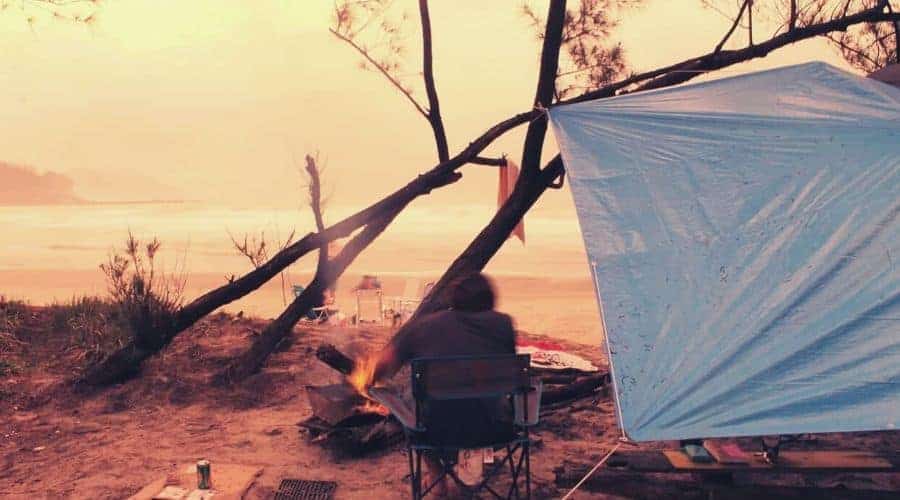
20. Rig A Drying Line Under Your Tarp
The most effective way to dry clothes in wet conditions is to string up a cord directly beneath the covering tarp used for your outdoor relaxation area (as mentioned above) and there you have a drying line. To prevent laundry from interfering with your space, secure one end of the rope with a trucker’s hitch, allowing you to easily adjust the line’s tension after securing it in place.
21. Bag Up Your Damp Clothes
If you can’t hang damp clothes, storing them overnight in a dry bag ensures their odor won’t disturb your sleep or give you a nasty surprise in the morning. It also prevents the moisture in the clothes from contributing to condensation inside your tent.
22. Use Your Bivvy Bag To Create A Vestibule
Emergency bivvy bags (or “space blankets”), carried by most hikers and campers, can double up as a dry doormat/vestibule area when laid outside your tent door. This provides a space to leave wet rain gear in as well as an area to change in and out of wet clothes (when under a tarp!).
If you’re camping with others, you can use both yours and their bivvy bag to create a simple awning by tying two corners of the bag to the front of your tent with a cord and suspending the other two corners with a pair of hiking poles.
23. Stash Dry Wood Under Your Car
When car-camping, the perfect way to keep firewood dry is by stashing it under your vehicle. Bringing firewood along with you ensures you have a ready supply of dry wood, or if you do have to hunt for the driest stuff you can find, you can then dry it out under your car.

24. Change Clothes Before Bed
Always change into your driest clothes before bed and hang your wet items under your tarp (see above). Drying a damp or wet sleeping bag is nigh-on futile in the absence of sun and dry conditions. Sleeping in wet clothes, moreover, isn’t an experience we’d recommend.
25. Slow-Dry Gear In Your Sleeping Bag
In a pinch, or when you’re short on dry clothing, speed up the overnight drying process by stuffing damp gear in the bottom of your sleeping bag. The warmth from your body heat should help dry out some moisture, or at the very least, make it a little warmer.
26. Know When Enough Is Enough
Know when enough is enough; at a certain point camping in wet weather progresses from being a valuable, make-the-most-of-it experience into something a little more masochistic.
While roughing it for a few days in moderate showers is both commendable and potentially highly enjoyable if things take a turn for the torrential with conditions preventing you leaving your tent entirely, then it may well be time to call it a day.
27. Clean And Air Out Your Gear
When you return home, make sure to clean, dry, and air out all your gear, including your tent, tarps, footprint, backpack, and sleeping bag. First, rinse off any dirt, then clean with a mild, non-detergent soap, and finally, hang out to dry either over a line or indoors at room temperature. Your family or flatmates may not appreciate it, but they’re unlikely to quibble with someone who’s just attained the status of a card-carrying Backcountry Badass.
How did you like our tips for tent camping in the rain? If there’s any advice for camping in rainy weather you think we’ve missed, let us know in the comments box below!
Save for later!!! ⤵️
